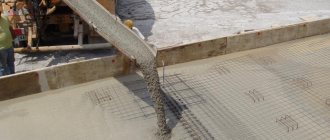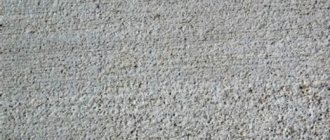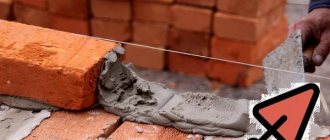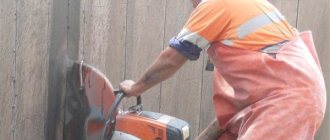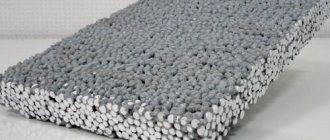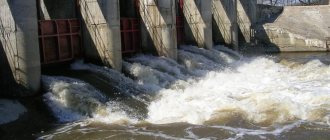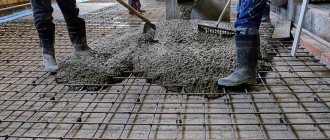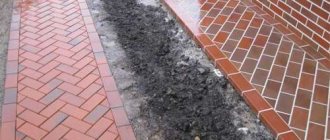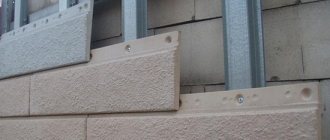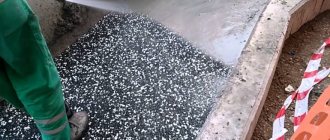Who among us does not dream of a country house far from the bustle of the city, gray buildings, and poor ecology. If there is a plot of land, all that remains is to build a house.
Build your own house?! Somehow I asked myself this question. And along with this, a bunch of different questions arose: what materials to use in order to build cheaper, how to make a heating system (for example, air heating of a house without a fan), thermal insulation, sewerage, water supply. I wanted an eco-friendly house, made from natural materials, which could be called a “Green House”. In the modern world there seem to be no problems with materials, there are plenty of them on the market, but I was more interested in building from alternative materials such as straw, clay, reeds, etc., in general, what nature provides and what you can get yourself and on your own site. Below I will describe each of the materials and construction methods. In my opinion, these methods are quite simple, strong, thermally efficient, environmentally friendly and cheap. The thickness of walls made of any materials depends on climatic conditions. The lighter the materials, the thinner the walls, and vice versa.
These materials and construction methods were widely used in the old days and have been forgotten in our time. I would like to remind you of these methods of producing building materials.
Artificial sandstone without firing
Relatively recently, the scientist Rance invented a method for producing artificial sandstone without firing, but for unknown reasons this method was forgotten and is not used in Russia to this day. At least not widely used. Using Rance's method, it is possible to obtain sandstone of any size and shape. It can be used both for wall masonry and for small architectural decorations.
It consists of ordinary sand and clay or other mineral substance (earth or siliceous binder) to make the mass solid.
If you use silica, it turns into silicic insoluble lime and this mass acquires the properties of old Roman cement, which is very durable.
Preparation is as follows:
Sand (mineral substance) and soap are mixed with a certain amount of dissolved soda glass (consists of a mixture of quartz powder, calcined soda and coal or quartz powder, calcined Glauber's salt and coal. Finely ground soluble glass when boiled with water gives a solution. You can also buy it .). This can be done in any convenient way, be it with your feet or with a shovel.
The resulting mass is pressed into molds and rolled into layers. After this, it is saturated with calcium chloride (a metal that is part of limestone, such as chalk). The cost of preparing sand stones and plates is less than the price of natural stones.
The main benefits are as follows: easy to manufacture, does not require special devices; can be manufactured on site; use of readily available materials; the material turns out to be very similar to natural, and it can also be painted in any color; if necessary, sandstones can be made hollow; artificial stones do not erode in the air; stones have high hardness.
How to deal with shortcomings?
To avoid all of the above disadvantages, a special technology was invented. Its essence is as follows: part of the sand, as well as cement, undergo additional grinding. Until the specific surface area reaches the desired value. After this, vibration mixing of the mixture (concrete) occurs, which contains a minimum of water. However, it is enough for closing.
Then surfactants are added to the mixture to improve its basic characteristics. The method of delivering the mixture to the place of application is vibration transportation. During the laying process, vibration (high frequency) under pressure or with a weight is used.
Due to reduced mobility and increased viscosity, mixtures of this type are less workable than traditional concrete. In addition, there is a high probability of macropores forming during the processing of the mixture, as there is a lot of air between the small grains. It is not easy to remove for two reasons: increased structural viscosity and dispersion. Therefore, serious attention is paid to the quality of the aggregate. These include requirements for the grain composition and the percentage of impurities. The sand that is planned to be used to prepare the mixture should be pre-enriched and therefore used as a compacted mixture.
Giving moderate rigidity to mixtures of the described type, strength and increased frost resistance is possible using special procedures:
- compaction;
- vibration compaction;
- pressing;
- vibration mixing.
The choice of one method or another depends on the rheological characteristics of the material.
Also, improvement of the basic properties of concrete is achieved through the inclusion of special fillers in its composition. Their introduction occurs at the cement grinding stage.
Adobe brick
This is a brick that has been air dried but not fired. It is prepared from clay, sand and fibrous additives (straw, firewood, moss, etc.). The composition of adobe will depend on the fat content of the clay: for 1 m3 of mass take 3-4 parts of clay of medium fat content, 1 part of sand and 8-10 kg of fibrous fillers; for 2-3 parts of fatty clay, 1 part of sand and 11-14 kg of fibrous fillers; 1-2 parts very fatty clay, 1 part sand and 15-18 kg of fibrous fillers.
The quality of the clay will be better if it is prepared in the fall in an open heap of no more than 1 m. After being saturated with water, in winter it will freeze, swell and loosen.
It is better not to use skinny clay because... the brick it makes is brittle. To prepare adobe, first make a solution of sand and clay, mixing until smooth. Then, for example, straw chaff is moistened with water and added to the mass and mixed thoroughly. It is very convenient to mix (knead) with your feet, which throws out pebbles and other foreign objects. The mashing continues until a thick dough-like mass is obtained. Blocks are made from adobe using a mold 35.7x17.3x13 cm. At the bottom, the mold is made 2-3 cm wider, this will make it easier to remove the mold. Before laying, the mold is moistened with water and sprinkled with sand or chaff, bonfire, etc. Having filled out the form, the mass is kneaded with hands (especially in the corners), and the excess is removed with wire (board), the cut is sprinkled with bonfire or moss, after which the form is removed, and the block is dried in within 7-15 days.
In this case, it is good to first pierce the block through in five places. To do this, you can make a fork with five iron teeth, 1.3 cm thick. These holes will significantly speed up the drying speed and make it more uniform. After a day, the brick is placed on its edge and remains in this position for 2-3 days, after which the bricks are laid out to dry. It is best to choose a place for drying in the shade under a canopy.
Bricks should be installed on edge and stacked in the form of straight pillars, two bricks at a distance from each other by the thickness of the brick; The second row is placed across the first two bricks in the same order, etc. a brick is considered dry if the color of the middle in the fracture is the same as the outer color.
Since adobe brick is not fired, drying is of great importance, including for the sanitary and hygienic condition of the premises.
When drying a brick, it is useful to shift it at least once, the top ones down, the bottom ones up, this will allow it to dry better.
A good adobe block should be dry, without cracks, not break when dropped from a height of 2 m and not fall apart in water within 24 hours.
The walls are laid out on thick clay dough or on the same mass from which adobe is made. The seams should be made no more than 1 cm. After a year, they are plastered with a lime-clay solution of 1:1:0.5 composition, adding chaff or chaff. In order for the mortar to hold firmly, you need to drive 7 cm long wooden pegs into the masonry joints every 10-15 cm to a depth of 5 cm.
For uniform unloading, plates must be placed under the floor beams; windows and doors should be made no closer than 1.5 m from the corners; partitions should be at least 0.9 m. To lay the floor beams along the top of the walls, a continuous frame is made of boards connected in half a tree and fastened with nails or screws. The wooden ends of the lintels should be placed 25 cm into the walls and partitions. The roof should hang down no less than 60 cm, and the walls themselves should be protected from precipitation. It is best to line the outer side with baked brick. And this brick wall should be laid on no more than 2 floors.
Adobe bricks, well dried and made from good clay, provide good building material. Premises made of such material are dry and warm, fire safe, cheap and easy to build.
Sand concrete. Theory. Study. Application practice.
The use of sand concrete is one of the priorities of the Russian construction industry. Deposits of coarse aggregate on the territory of the country are located extremely unevenly, and high-strength aggregates - necessary for producing high-grade concretes - are generally calculated in just a few. In a number of regions of Russia and the CIS countries, only imported crushed stone is used, and its cost is the main component of the cost of concrete. Annual transportation of coarse aggregate for concrete across the Russian Federation is 80 billion tkm. Sand is a ubiquitous local building material, and its cost is 2 to 4 times lower than the cost of crushed stone. The significant interest shown in recent years in sand concrete abroad is also caused by environmental factors: the extraction of crushed stone means the destruction of mountain ranges, which has already led to irreversible climatic consequences in Russia (Kislovodsk, Zhiguli). The author of the monograph is Prof. K.I. Lvovich has been studying sand concrete for many years: theory, material properties, designs, technologies, equipment for preparation and molding, features of joint work with reinforcement, methods of designing compositions, chemical additives, sand fillers, etc. Based on the proposed the author of the classification systematized and summarized domestic and foreign publications on sand concrete and in 2007 published the monograph “Sand concrete and its use in construction” S-P, Stroybeton. This monograph included the results of research on the use of sand concrete in the prefabricated reinforced concrete industry and was intended mainly for engineering and technical personnel of reinforced concrete and DSK plants, whose goal was to transfer the enterprise (individual production lines) from heavy to sand concrete. Issues of material theory, research into the properties of sand aggregates, the development of new types of sand concrete, including those used on construction sites, the results of research in recent years and, first of all, the wall load-bearing heat-protective product “thermoblock” and the low-rise construction system “Thermoblock” are included in this publication, which can be used as a textbook, as reference literature and as recommendations for enterprises in the construction industry that aim to improve the quality and reduce the cost of housing, road, and engineering construction.
Earth walls
The walls are very strong and durable, they practically do not shrink, do not form cracks, swell little from dampness, and have a low thermal conductivity coefficient. Buildings made of such material are erected no more than 2 floors. The most important thing when building earth walls is to choose the right components and prepare an earth hammer from them.
Such walls can be erected anywhere where they can dry out over the summer. After 20-30 years, the strength of the excavator increases.
The thickness of the external walls must be at least 50 cm; the internal load-bearing elements of the first floor are 30-40, the second 25-30 cm. In terms of thermal conductivity 50 cm, the wall is equal to a brick wall of 2.5 bricks. With earthen walls, the roof should hang down at least 60 cm.
Earth bits are prepared from different soils. The plant layer, peat, silty soils, fatty soils (give more shrinkage) and lean soils (fragile) are considered unsuitable. Therefore, oily soil can be diluted with lean soil (up to 50%), shavings, firewood, straw, etc. Lean soils are mixed with clays (up to 40%). A small amount of organic impurities and small stones will not reduce the quality of the earth breaker. Also, when adding straw, firewood, shavings, the thermal conductivity of the soil decreases and it becomes lighter.
A well-selected, laid and seasoned earth bit should have good nailability, i.e. must fit firmly and bend at right angles without splitting the material.
The soil, if it is suitable for the excavator, can be taken from the trench under the foundation or if a basement is being dug. Soil humidity should be 10-16% (soil compressed into a lump does not crumble).
The suitability of the soil can be determined in different ways. If the slopes and walls of the ditches do not crumble, the soil is suitable for building walls, or clods of earth do not fall apart with a shovel.
To obtain a more durable structure, the walls are reinforced with bars, sanded poles, wire, etc. (Figure 1)
Figure 1—methods of reinforcement of earthen walls: a—connection of a frame made of wire or branches; laying ties in corners and adjacent walls; c- laying the frame in the form of a ladder; 1, 6 pins; 2- chamfer; 3, 5 - wire; 4- branches; 7 – poles; 8 - wall thickness; wire fastening; 10 – bar.
Construction proceeds as follows. A layer of soil mass is placed in formwork made of boards and compacted so that it is reduced in volume by half and the tamper begins to bounce off. They tamp the beginning near the formwork and then move to the middle. It is best to lay and compact the mass along the entire perimeter. To insulate corners, it is recommended to make chamfers equal to the thickness of the wall. To firmly bond the layers together, the surface of the previously compacted layer is scratched, and it will be even stronger if it is loosened and poured with a thin layer of lime mortar. Plates are laid under the floor beam.
Earthen blocks can also be made for construction.
Fine-grained concrete mortars
For small volumes of construction work, it is worth using ready-made dry mixtures, which contain sand of large fractions; the average price for a bag weighing 40 kg is rubles.
Contents: Technical characteristics of concrete Scope of application Price of ready-mixes What is fine-grained concrete? Properties and characteristics The exact parameters of the mixtures depend on their purpose; fine-grained concrete includes concrete with a binder ratio of up to .5 with the addition of superplasticizers.
The number of frost resistance cycles is at least double that of conventional brands. For comparison, ready-mixed concrete B25 achieves F and higher.
With equal weight to concrete with crushed stone, the structure of fine-grained varieties is porous and completely homogeneous. This material belongs to a large group of heavy concrete and is also classified as artificial stone. Depending on the composition, the final product is not only endowed with certain properties, but can also be used in various fields of construction.
Mud buildings
Construction with clay is a very ancient method. The building mixture consists of clay, sand and straw. The clay mixture is technologically advanced: it practically does not shrink and is well shaped. This method is quite cheap and does not require special knowledge. Adobe construction has its drawbacks: it is built slowly, is susceptible to dampness, and has greater thermal conductivity than wood. Construction with clay is as follows: the clay is rolled into small balls similar to a loaf of bread, and a wall is sculpted from them.
Description of material
Concrete M200 is indispensable in private and residential construction. Reinforced concrete structures made from such a building mixture can withstand long-term loads, which allows them to be used for the construction of buildings 5-6 floors high. Today on sale you can find various types of concrete of strength grade M200, which will differ in their strength indicators, moisture and frost resistance and a number of other characteristics.
This material is made from M400 Portland cement and may include fine-grained and coarse-grained fillers. Accordingly, its characteristics, mobility and ability to maintain strength over a certain period of time will differ.
Thanks to the use of various plasticizers and additives, it is possible to significantly change the characteristics of the final mixture, but all production of M200 concrete is carried out exclusively in accordance with GOST in compliance with the recipe of this material.
It is customary to distinguish between the following types of concrete M150 and m200, depending on the characteristics of the material:
- According to the purpose of the mixture: for industrial and domestic construction.
- Type of binding material: gypsum, cement, silicate and with the addition of polymers.
- Fractions of solid fillers used: fine-grained and coarse-grained types of crushed stone.
- Density and elasticity of the composition: porous, dense, special purpose.
- Type of maturation: with natural hardening and autoclave compositions.
- Depending on the volumetric mass indicator: lightweight and heavy.
Provided the correct choice of such material, it will be possible to ensure maximum durability of the erected buildings, their resistance to pressure and other adverse environmental influences.
READ Characteristics of M600 concrete and its application
The most popular are cement coarse-grained dense varieties, which are used with equal success for the manufacture of reinforced concrete structures, pouring foundations and erecting structures using monolithic construction technology.
Cinder block walls
Cinder concrete can be used to make monolithic infill and block walls. They are durable, low thermal conductivity, fireproof, cheap, etc.
Cement, lime, gypsum, and clay can be used as binding materials for slag concrete. The strongest ones are cement and lime. The filler is slag, clean, sorted on sieves with cells of 40x40, 5x5 and 1x1 mm. The slag is first sifted through a 40x40 sieve, then 5x5 mm. Anything that does not pass through a 5x5 sieve is considered large. Next, sift through a 1x1 mm sieve. It turns out two fractions, large and small. 60-70% coarse and 30-40% fine slag are mixed with one or two binders (Table No. 1).
Table No. 1 - Composition of slag concrete and its grade.
To increase strength, the slag should be moistened several hours before preparation.
When preparing cinder concrete of a certain brand, you need to take into account not only the amount of material taken by volume, but also the grade of cement (Table No. 2).
Table No. 2 - Brand of slag concrete depending on the brand of cement (materials in volumetric parts, cement: slag mixture)
The technology for preparing slag concrete is very simple. Measure out large and small slag, shovel the mixture, add cement, shovel everything very well, moisten it with water and mix everything again until a homogeneous mass is obtained. If the mixture is made with gypsum, it must be used immediately.
Pressed (self-leveling) walls are made using adjustable formwork. The walls can be made monolithic or hollow. Inserts are used to create voids. The number of voids is made from one to three, and then they are covered with dry slag, peat, etc. The frequently used block size is 390x190x188 mm.
The use of sand concrete in capital construction
Sand concrete is used mainly in the construction of buildings and performing rough finishing work. It is excellent for pouring concrete floor screed, as well as for leveling the surface before laying tiles and laying the final floor covering (linoleum, laminate, etc.). It is also often used in the manufacture of load-bearing structures and pouring monolithic foundations. This product is also irreplaceable when sealing joints between blocks and filling joints between reinforced concrete structures. Sand-concrete mixture is also widely used in laying bricks and making wall blocks, concrete panels and monolithic slabs. In addition, this material is used for emergency repairs during emergency response, construction of highways and construction of airfield runways. The composition of sand concrete varies depending on the design requirements for its quality - strength, moisture resistance, resistance to negative temperatures, density and other properties. The strength class of this mixture varies between indicators - from B10 to B90. The strength level of concrete depends on the quantity and quality of cement included in its composition. In private construction, B15 sand-concrete mortar is usually used, and in industrial construction, high-strength sand concrete B90 is used.
Sawdust concrete and fire concrete
Walls made of these materials are strong, have low thermal conductivity, and are durable. When properly manufactured and protected from moisture, they last a long time. The foundation and roof, which should hang down at least 60 cm, also have a strong influence. The outside walls should be plastered so that they are not saturated with excess moisture. For strength, the walls are reinforced with brushwood or wooden slats, windows and doors are located 1.5 m from the corners, the width of the partitions is at least 1 m, the ends of the lintels are at least 25 cm.
Sawdust concrete is a good material for external walls. Wall thickness depending on outside temperature minus 20-30cm; 30-35; 35-40; 40-45 cm. The thickness of the internal walls is at least 30 cm.
To prepare the mixture, sawdust must be sifted through a 1x1 cm sieve, then mixed with sand and poured with cement-lime mortar. Lime-cement mortar is prepared by mixing cement and lime paste. everything is thoroughly mixed and placed in formwork.
Table No. 3 - the need for materials to produce sawdust concrete 1 m3
Bonfire concrete is prepared as follows: 135 kg of cement of a grade not lower than 400, 500 kg of sand, 60 kg of flax or hemp kernels and 250 liters of water. The fire is first mixed with sand, then poured with cement milk, mixing thoroughly (the mass should stick to your hands).
Composition and types of fine-grained concrete
The main difference between fine-grained concrete and other types of artificial stone is, of course, its composition. No coarse aggregate is used in its manufacturing process. Thanks to this technique, the final product acquires a homogeneous structure with a specific surface area of solid mass and high porosity.
Main components:
- Portland cement or fine-grained cement. The latter is used in cases where the production of any reinforced products and structures is required.
- Fine-grained filler. Various materials can act as it. For example, crushed lime or ordinary ash. But, most often, sand of large fractions is used. When using fine sand, it is enriched with crushed gravel.
In addition to the key components, depending on the planned area of application of concrete, a unique component is added to it, which gives the artificial stone special properties. It is the introduction of such materials that makes it possible to classify fine-grained concrete into various types.
Reinforced
In addition to using the main components of fine fractions, during the production process the finished mortar is additionally reinforced with masonry mesh. This tandem gives the final product strength that works well in both compression and bending. This type of fine-grained concrete is actively used in the construction of load-bearing structures of small thickness.
Silicate
To increase the resistance of products to the effects of a humid environment and high temperatures, calcium silicate is introduced into its composition. Ordinary fine-grained concrete can easily withstand temperatures up to 300 0C, and the similar ability of structures based on liquid glass increases almost 4 times.
High strength
To increase the strength characteristics of fine-grained concrete, additional plasticizing additives with narrowly targeted action are introduced into the composition. To increase the effect they create, instead of the usual filler, glauconitic sand is used.
Modified
Special additives are added to the composition of modified concrete. Only now they are selected from a number of modifying chemical compositions that can improve all the performance characteristics of the material to the maximum level. Using them in different proportions allows you to “play” with the structure of the artificial stone each time achieving the desired properties and characteristics.
Lime sand concrete
Walls made of lime-sand concrete are quite strong; their conductivity depends on the filler used. The walls must be at least 50 cm, internal 30 cm, the width of the walls must be at least 1 m, the distance of openings from the corner must be at least 1.5 m. Proportions for preparing the mixture are in table No. 4.
Table No. 4 - composition and requirement of materials for the preparation of 1 m3 of lime-sand concrete.
The preparation technology is not complicated: first, the binder is mixed with sand, then this mixture is mixed with gravel or crushed stone.
Working mixtures
The composition and proportions for preparing the mixture may vary somewhat, both in terms of the binder and the filler and the use of special additives.
Mixture composition
Portland cement grades M400 or M500 can be used as a binder. Depending on the operating conditions, corrosion-resistant pozzolanic and sulfate-resistant cements can be used.
A fine-grained, homogeneous structure occurs when using fine filler. For this purpose, coarse, well-washed river sand with a grain size of 0.3 to 5 mm is used.
When selecting sand coarseness, you should stick to the “golden” mean. The use of particles whose sizes exceed 5 mm leads to a reduction in cement consumption and at the same time reduces the strength of the final product. Fine (silty) sand increases the density of fine-grained concrete, but at the same time leads to a sharp increase in binder consumption.
The optimal granulometric composition of the filler is obtained if a three-stage preparation method is used. In this case, sand fractions of different sizes are mixed in a certain ratio.
In addition to the binder and filler, water must be added. To make the solution more fluid, it is possible to add auxiliary substances - plasticizers.
Preparing dry ingredients
To obtain a working solution of proper quality, a number of conditions must be met:
- the shelf life of cement should not exceed the limits established by the manufacturer;
- the presence of hardened and caked lumps is not allowed in the binder mass;
- The filler should be free of clay impurities, debris, and traces of organic matter.
Clean and washed sand is sifted. To obtain different fractions, a three-stage preparation method is used on sieves with different cell sizes:
- 5–1.25 mm;
- 1.25–0.3 mm;
- 0.3–0.15 mm.
Then the resulting fractions are mixed with each other in a certain ratio:
- first (largest faction) – 50-60%;
- the remaining 50–40% comes from two other fractions, which are taken in equal proportions.
Mixing
Next, mix the binder and filler. Depending on the operating conditions and the required strength characteristics, the composition of fine-grained concrete may vary slightly. The ratio of cement to sand can vary from 1:1.5 for high-strength “fat” mortars, to 1:3.5 for “lean” mortars.
The amount of water and, if necessary, plasticizer that must be added is determined in each specific case separately. The determining parameter will be the rheological characteristics of the working solution. The appropriate density, fluidity of the mixture and strength of the concrete monolith during hardening must be ensured.
High-porous concrete
To prepare this concrete, Portland cement, gravel or crushed stone, etc. are used, without adding sand. The crushed stone size is 10-20 mm. As a result, voids (air pockets) are formed in the concrete, reducing its mass and thermal conductivity. Recommended composition in table No. 5.
Table No. 5 - composition of large-porous concrete
What is included in fine-grained concrete?
The main difference between fine-grained concrete and other types of artificial stone is, of course, its composition. No coarse aggregate is used in its manufacturing process. Thanks to this technique, the final product acquires a homogeneous structure with a specific surface area of solid mass and high porosity. In addition to the key components, depending on the planned area of application of concrete, a unique component is added to it, which gives the artificial stone special properties.
It is the introduction of such materials that makes it possible to classify fine-grained concrete into various types. In addition to using the main components of fine fractions, during the production process the finished mortar is additionally reinforced with masonry mesh.
Chopped log walls
Log houses are probably one of the most ancient and widespread building materials in our country. To cut down houses, it is necessary to use high-quality wood that is not infected with fungus or wood-boring beetles, and that is well dried. For felling, logs of the required length and diameter and preferably of the same thickness (rounded logs) are prepared. If this is not possible, then trees are selected according to the top cut - diameter with an acceptable difference between diameters of up to 30 mm.
The butt sides are trimmed from the inside to a thickness equal to the upper diameter, giving their ends an oval shape. The hewing of logs is carried out from the top with the transition to the butt.
In the process of cutting a log house “with the remainder” or “into the corner,” the logs are cut with their ends (the thin end is placed on the thick end) Figure 2.
It is easier to cut a log house from logs of the same thickness, for example, a “paw-to-foot” log house. In order to lay thermal insulation between the logs, when cutting, select a bowl from the bottom side of the log (Figure 4). The width of the grooves depends on climatic conditions, for example, at -30° the groove width is 120 mm, at -40° the groove width is 140-160 mm. The best groove shape is semicircular, the worst is triangular. For strength, the crowns are fastened along their length with spikes.
Caulking of the walls is carried out in two stages, the first after the construction of the walls, the second after a year and a half. I cover the insulation of the corner joints “in the paw” with boards over the laid insulation.
In walls of increased length, it is necessary to arrange transverse internal walls by tying them “in a circle” or “in a paw”. The internal walls are placed one after the other every 6.5 m, if the distance is greater, compression should be installed.
A log house made of raw wood must be dried for 2 years.
Figure 2 - cutting wall corners: a - simple connection; b-complex connection with a hidden spike, c – “burst” with the cup facing up.
When cut “in the clear” with the cup facing up, houses last for hundreds of years.
Figure 3—performing operations when cutting “into the head”: a- marking the cup; b – cutting out the bowl; c – groove marking; d – cutting out an oval groove (the dotted line shows the boundaries of the groove); 1 – line; 2 – marking line; 3 – groove boundary; 4 – groove depth; 5 – notches; 6 – groove.
Figure 4 - shape of the grooves: 1 – good; 2 – bad.
Figure 5 - cutting the corners of the walls “in the paw” and the order of its marking: 1 - groove; 2 – spike.
The technique of cutting “in the clear” (Figure 3), is simpler than cutting “in the paw”, Figure 5.
Features of the solution
Fine-grained concrete mixtures are difficult to manufacture. Due to the lack of coarse filler, it is quite difficult to independently optimize the granulometric composition of fine fillers. Therefore, such solutions are more profitable and easier to purchase in ready-made form.
The properties and main characteristics of the fine-grained mixture depend on various factors. First of all, it depends on the quality, type and quantity of fillers. The better the composition is optimized, the higher its performance characteristics. The main feature of fine-grained concrete is its amazing uniformity. The mixture has excellent porosity and a large surface area of the solid mass.
Construction from timber
Building walls from timber is much easier than from logs. . The cross-section of the beams is taken depending on the design temperature of the outside air: at -30° - 150x150 mm, at -40° - 180x180 mm. For internal walls 100x150 mm or 100x180 mm. In the corners, the beams are connected in the same way as logs “with remainder” and “without remainder,” i.e. “in the cloud” and “in the paw”, etc. for strength, main tenons or insert tenons located vertically are used (Figure 6).
When making a log house, the timber is stacked on top of each other with heat-insulating material laid between them.
Figure 6 - cutting walls from beams: a – cutting a corner into a dressing with a root tenon; b – cutting a half-wood corner using dowels and insert dowels; c – connection of walls made of beams on dowels; d – the same from tongue-and-groove beams with inserted slats; d – mating corners on keys; g – connecting the inner wall with the outer wall into a dressing; h – the same in a frying pan; and - also in a half frying pan; j – supporting the ends of the beams on the internal walls with a joint in the middle of the thickness of the wall; l - the same with bypassing the ends; 1 – chamfer 20x20 mm; 2 – root spine; 3 – dowels; 4 – keys.
The beams are connected along the length with dowels.
Concrete mixture from ASG for the foundation
Concrete for the foundation.
Since the foundation takes the heaviest load from the walls, ceilings and roof, the material for its construction must meet the appropriate strength requirements. Nevertheless, it is recommended to build low-rise buildings, for the construction of which various proportions of ASG and cement are used for concrete grades M100 and M150.
The numbers for preparing the classic proportion are as follows (the ratio of cement and sand-gravel mixture with water is calculated):
- cement - 1 part;
- ASG - 8 parts;
- liquid (water) - ½ volume of cement.
It is recommended to use cement grades M400 or M500; the sand and gravel composition should be enriched, preferably from group V, with the highest gravel content.
The volume of components can increase or decrease depending on the moisture content in the material, as well as on the composition of what viscosity is required to be obtained at the output. However, when using water, it should be taken into account that its amount should not exceed 1 part of cement.
Wood frame walls
Frame construction is probably the simplest of construction methods; they are easier to build with your own hands. They are warm and low sound permeable.
The frame consists of upper and lower frames, walls, stiffening struts and auxiliary elements such as posts and crossbars between which window and door openings are located.
Houses with two floors can be built using two main types of frames: with through racks on two floors, and with floor racks, like one house on top of another. The frame of the first type is very resistant but requires long material, the second type is simpler and allows the use of short material.
Figure 7 - frame design and its details: a - general view; b – strut notch; 1 – strut; 2 – crossbar; 3 – stand; 4 – lower trim; 5 – floor beam; 6 – top trim; 7 – ceiling beam; 8 – beam; 9 – harness.
Figure 8 – options for filling the frame: a – reeds (or other insulation); b – backfill; 1.4 reeds; 2, 5, 8 – racks; 3 – plaster; 6.10 – thick glassine paper; 7 – casing; 9 – backfill.
The supporting racks of the frame are placed at a distance of 0.5 to 1.5 m, depending on the size of the windows and doors. The corner posts of the frame are made of beams or composite boards, and the row posts are made of boards. The lower frame is assembled from beams, logs or boards. To give the frame rigidity, plank struts are placed between the posts, cutting them flush. An upper frame is placed on top of the racks, into which the ceiling beams are cut, and rafters are placed on the beams.
The assembled frame is sheathed on the outside with boards, plywood, chipboard, asbestos-cement boards or other material. The covering material must be resistant to precipitation.
The inside of the frame will also be sheathed. Insulation is laid between the skins. Insulation materials can be rolled, slab or loose. Roll and slab materials are attached to the frame with nails, or better yet, with special plastic dowels. The seams are coated with gypsum mortar or caulked with tow. If there is two layers of insulation, it is necessary that the slabs of the second layer overlap the seams of the first layer. When using reed slabs in a single-layer installation, the stems should be positioned vertically; in a two-layer installation, one layer is installed vertically and the other horizontally. If straw slabs are used, they should be soaked for 2 hours in a solution of iron sulfate and dried thoroughly (this will protect against rotting and rodents). Airflow is reduced if thick paper, cardboard, etc. are placed between the layers.
To prevent the insulation from becoming moistened, a vapor barrier is installed on the room side. Windproof material on the outside.
When using backfill material, it is mixed with fluffed lime, at least 10% of the volume of backfill material, and everything is thoroughly mixed until the composition is homogeneous. This will prevent rodents from breeding in the insulation.
Materials for backfilling can be slag, pumice, sawdust, moss, peat, sunflower husks, firewood, tow, chopped reeds, straw, etc. The lighter the material, the lower its thermal conductivity. All organic materials (sawdust, straw, etc.) are antiseptic and dried.
You can also use moistened backfills, which after drying become a solid filler. The moistened backfill is made from the same materials as the dry backfill, only a binder is added. The advantage is that it does not shrink, unlike dry.
What is fine grain concrete?
When choosing the type and class of concrete, the main criterion is the expected loads; in some cases, standard grades with coarse aggregates are not suitable and require replacement with homogeneous fine-grained mixtures. This need arises when concreting densely reinforced and complex monolithic structures, road construction and repair work. The approach to mixing differs from the preparation of conventional solutions; due to the difficulties in selecting and sorting the filler, it is easier to buy them at the factory or in dry form.
Features, composition and GOST
The main difference from conventional brands is the complete absence of large fractions, the maximum grain size of the introduced components is 5 mm. According to GOST 26633-2015, fine-grained concrete includes mixtures with a dense structure (within 2000-2500 kg/m3) based on a cement binder and durable fine filler. The latter is represented mainly by natural and artificial sand, screenings of gravel or crushed stone chips, grinding of ash and slag and similar finely dispersed components. Polymer additives and fiber serve as reinforcement.
Taking into account the high requirements for the density of the material, the functions of the inert component are most often performed by polyfractional quartz sand. The aggregate size is controlled using sieves with mesh sizes within 2.5 mm for the first group, 1.2 for the second, and 0.135 for the third. The ratio of binder to sand depends on the expected class of the mortar being prepared and varies from 1:2 to 1:4. The absence of large fractions leads to excess consumption of cement by 20-40%, its maximum share in 1 cubic meter of fine-grained mixture is 750 kg (for comparison, in conventional brands - 550), which negatively affects their cost. The minimum acceptable strength grade in this case is M400, preferably more.
The ratio of fractions of the first group (with a grain size in the range of 2-5 mm) in fine-grained sand concrete reaches 60%, the share of the second and third does not exceed 40%. This is due to an increase in binder consumption with an excessive content of dust particles and a deterioration in this case of mobility. To ensure uniform distribution of the cement paste, plasticizers must be introduced into the composition, most often modified polymers. The water-cement ratio varies in the range of 0.28-0.4. With the correct selection of proportions and good quality sand, the output is a material with a high specific density, suitable for complex and densely reinforced systems.
The main characteristics of fine-grained concrete include the presence of a dense and homogeneous structure, high axial bending strength, and good moisture and frost resistance. An increased proportion of cement and a significant specific gravity of the filler (in the range of 2000-2800 kg/m3) leads to an increase in the load from structures poured using such mixtures and complicates their processing. Drilling, cutting or similar mechanical operations are only possible when using diamond-coated attachments. An important characteristic of such compositions is high porosity; to achieve standard and design strength, they require compaction (which is especially important for hard varieties).
Scope and nuances of application
The scope of use of such concretes includes:
- Construction of objects with thin walls, domes, vaults, openwork structures and bas-reliefs.
- Pouring densely reinforced systems. In this case, special attention is paid to the introduced plasticizers; they should not increase the corrosive effects.
- Sealing and repair of reinforced concrete joints, filling voids. Fine-grained mixtures with the addition of fiber and polymer plasticizers belong to the group of non-shrinkable concrete; for some factory grades the expansion coefficient reaches 0.05% or higher.
- Leveling and laying surface layers of horizontal screeds.
- Road construction: construction of pavements, canals and reservoirs.
- Pouring small-piece products: paving stones, slabs, border elements. When pressing or vibration processing in molds, their strength characteristics will be maximum.
- Construction of hydraulic structures.
The plasticity of fine-grained concrete largely depends on the type of additives and the method of laying; the best results are achieved when it is compacted by pressing (vibration - only if the volume of entrained air is controlled), compaction and the use of roller systems.
The size of the fractions allows for application by gunning; in this case, a pre-prepared solution or dry components combined in a nozzle with water are applied under pressure to areas of cracks or joints, forming a strong, adhesive and monolithic layer after drying. When properly prepared, these compositions are not afraid of delamination and remain viable for at least 120-150 minutes.
Price
When purchasing a ready-made mortar, the estimated costs, including delivery, depend on the strength grade and reach 3,700 rubles/m3 for M200 and 4,000 for M300. The minimum order quantity is 5-6 cubic meters, otherwise the cost of concrete increases.
Fine-grained mixtures can be bought in dry form, the requirements of GOST 26633 are met by the non-shrinking brand Tsemtech (at a price of 310 rubles per 25 kg), standard sand concretes are represented by the brands Rusean, Vilis, Eco, Kamenny Tsvetok and many others, they can be purchased wholesale and retail for 100 rubles for 40 kg.
Author: Valentin Tokarev
| Related articles: | |
| Reinforced concrete lintels Methods for treating concrete floors to prevent dust Concrete pillars and blocks for installing fences | |
Stone and brick walls
Walls made of brick and stone are strong, fireproof, but have high thermal conductivity.
Stone walls in our climatic conditions should have a fairly large thickness of 72-77 cm. For masonry, use limestone without cracks and contamination, laying it in even rows with careful bandaging of the seams (Figure 9). Large slabs and stones (the entire width of the wall) are not recommended, as they will freeze. The mortar can be clay, lime, cement-lime, cement-clay. When plastering, the masonry is placed in a waste area, and wire is inserted into the seams so that its ends protrude.
The walls can be made thinner if both the outside and the inside are insulated.
Brick walls can be massive or hollow (the voids are filled with heat-insulating material). To insulate the walls, they are plastered. When laying bricks, it is necessary to adhere to the dressing of the seams. Masonry comes in various types (Figure 10,11,12):
- well;
- with horizontal diaphragms;
- lightweight masonry.
Figure 9-ruble walls: a – rubble masonry with plaster; b – rubble masonry with thermal insulation; 1 – bottle; 2 – plaster; 3 – thermal insulation board.
Figure 10 - well masonry with vertical transverse walls: a - general view; b – top view; c – corner masonry walls; 1 – backfill.
Figure 11 - lightweight masonry with horizontal diaphragms: a – with brick diaphragms; b, c – with solution diaphragms reinforced with steel reinforcement; 1 – backfill or lightweight concrete; 2 – reinforcing steel; 3 – solution.
Figure 12—Fedotov’s lightweight masonry, general view; b – top view; c – corner masonry walls; 1 – backfill.
Specifications
The popularity of this building material is largely due to its excellent technical characteristics, which are combined with an affordable cost. In each specific case, the parameters of b15 concrete will vary, depending on the type of filler, cement base, additives and plasticizers used.
Main technical characteristics of concrete B15 M200:
- Compressive strength indicators are 196 kg per cubic centimeter.
- Water resistance - W 2 - W 6.
- Guaranteed durability of 15 megapascals.
- Mobility - P 2—P 4.
- Frost resistance - F50-F150.
- Density and specific gravity - 2400 kilograms per 1 m³.
It is recommended to prepare a composition with standard mobility W 2 directly on the construction site and use the prepared mixture literally within 20-30 minutes.
If long-term transportation is necessary, special plasticizers are added to concrete, which help prevent rapid hardening, making it possible to transport solutions on concrete trucks for one and a half to two hours.
The frost resistance class shows the number of freezing and thawing cycles that the material can withstand without deteriorating its performance characteristics. For outdoor use, it is recommended to choose types of concrete with a frost resistance rating of F150. This will ensure the durability of concrete structures and structures, the service life of which will be 50 years or more.
When pouring the mixture into formwork directly at the construction site, it is necessary to use materials with fillers with a fraction of no more than 20 mm. But for the manufacture of reinforced concrete structures, B15 concrete with crushed stone with grain sizes of 40-50 mm is used. This allows you to simultaneously reduce the cost of manufacturing building materials, ensuring the necessary strength and durability of the completed structures.
READ Technology for manufacturing reinforced concrete curb stones
The strength gain of M200 B15 concrete , like other heavy varieties of this material, occurs after pouring on the 28th day. The rate of hardening will depend on the specific type of material and ambient temperature. At temperatures above 20 degrees, concrete hardens quickly, so to prevent cracking of the surface, it should be regularly moistened. It is not recommended to carry out construction work using this brand of concrete at temperatures below zero.
Proportions and composition of the mixture
The manufacturing technology of grade B15 concrete is regulated by GOST requirements, which allows maintaining all the declared characteristics of the material, including its strength and moisture resistance. Production is carried out using standard technology from cement, crushed stone, sand and water.
The composition of concrete m200 per cubic meter includes the following components:
- cement - 265 kg;
- sand - 860 kg;
- crushed stone - 1050 kg;
- water - 180 l;
- plasticizers - 4.8 kg.
READ Composition of concrete grade M150 and its application
It is recommended to use Portland cement with class M400 and M500. It is possible to use materials with lower strength indicators, but the ratio of expensive components in this case only increases. It is preferable to use river sand; there is no need to sift and wash the material. The optimal fraction size is 1.3−3.5 mm. Additionally, crushed granite or gravel with a fraction of 10–40 mm is used as backfill.
Depending on the volume of the mixture being prepared, you can do it yourself manually or in small concrete mixers; it is also possible to order ready-mixed concrete directly from the plant, which is delivered by concrete mixers directly to the construction site. In the latter case, it is possible to guarantee the excellent quality of the material, as well as its full compliance with the declared characteristics.
High strength self-compacting sand concrete
To clarify the effect of cement consumption, the following compositions were proposed with cement consumption from 400 to 700 kg per cubic meter, with a dosage of the Melflux superplasticizer of 0.75% by weight of cement. To compare the properties, equal mobility mixtures of class SF1 were prepared, which for SUBs is normalized by a cone spread from 550 to 650 mm. One can observe an increase in the density of BS and a decrease in air entrainment from an increase in cement consumption. This dependence is due to the fact that the packing density increases and the voids are filled with cement paste. The maximum density was achieved with a cement consumption of 700 kg per cubic meter, and this figure increased by 4%. And air entrainment with cement consumption decreased by 40% and amounted to 5.1%.
MSUB samples stored under normal hardening conditions were subjected to compression tests on days 3, 14 and 28; it turned out that an increase in cement consumption leads to an increase in the kinetics of strength gain and maximum strength on 28 days. Thus, the maximum compressive strength from 35.7 MPa at a cement consumption of 400 kg per cubic meter increased by 42% and amounted to 61.3 MPa at a consumption of 700 kg per cubic meter.
To determine the effect of plasticizer dosage on the properties of SCC, the optimal composition of self-compacting fine-grained concrete was taken with a cement and sand consumption of 600 and 1600 kg per cubic meter, respectively, the filler consumption was 50 kg per cubic meter. The W/C ratio is most effectively reduced by the Melflux superplasticizer in an amount of 1% by weight of cement; the W/C ratio in this case is 0.32. However, delamination of the BS is observed, whereas when using the Sika additive, no delamination of the BS is observed. The minimum W/C ratio of this additive is 0.38 at a dosage of 2.5%. ReoTech has the highest W/C values among the three plasticizers studied. The minimum air entrainment is achieved by introducing the Melflux 2651F additive in an amount of 0.5% and is equal to 3.3%, while the Sika additive intended for self-compacting concrete at its maximum dosage of 2.5% produces an air entrainment of 7%. The ReoTech plasticizer has minimal air entrainment at a minimum dosage of 5.4%. The maximum density is achieved by introducing the Melflux plasticizer in an amount of 1% and is 2262 kg/m3, and when containing the Sika additive in an amount of 2.5% it gives a density of 2176 kg/m3.
After studying the influence of cement consumption and dosage of plasticizers, the following compositions of self-compacting concrete were proposed. The maximum strength on 28 days was 87 MPa, which is equivalent to class B65; when replacing with an additive from Sika or Reotech, we see indicators of 80 MPa, which corresponds to strength class B60. Such indicators were achieved by selecting the optimal grain composition of sand, increased cement consumption and the use of an active mineral filler - microsilica / Thus, the maximum density of the concrete mixture for self-compacting sand concrete was achieved at 2368 kg/m3.
